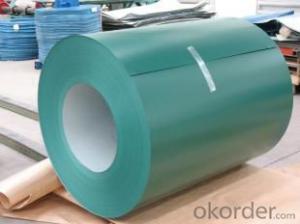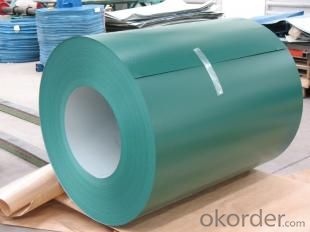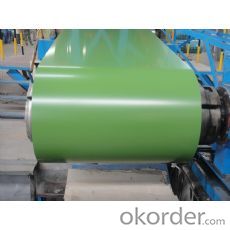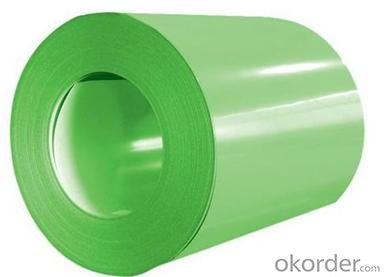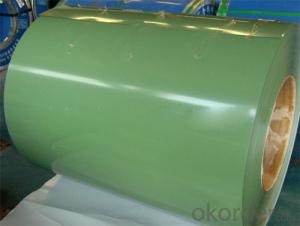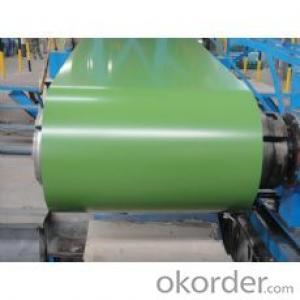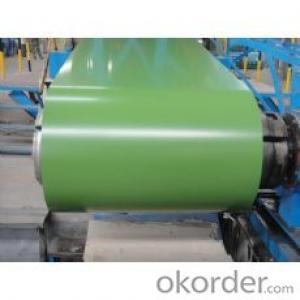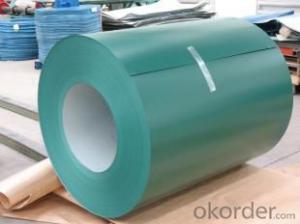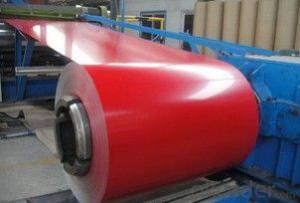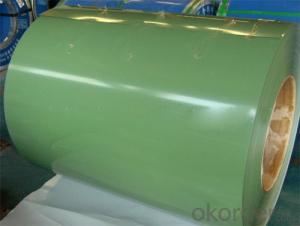Pre-Painted Galvanized Steel Coil High Quality Green Color
- Loading Port:
- Shanghai
- Payment Terms:
- TT OR LC
- Min Order Qty:
- 100 m.t.
- Supply Capability:
- 20000 m.t./month
OKorder Service Pledge
OKorder Financial Service
You Might Also Like
1. Pre-Painted Galvanized/Aluzinc Steel Coil Description:
With GI as base material, after pretreatment (degrease and chemical treatment ) and liquid dope with several layers of color, then after firing and cooling, finally the plate steel is called pre-painted galvanized (aluzinc) steel. Pre-painted galvanized steel is good capable of decoration, molding, corrosion resistance. It generally displays superior workability, durability and weather resistance.
2.Main Features of the Pre-Painted Galvanized/Aluzinc Steel Coil:
• Excellent process capability
• Smooth and flat surface
• Workability, durability
• Excellent heat resistance performance
• High strength
• Good formability
• Good visual effect
3.Pre-Painted Galvanized/Aluzinc Steel Coil Images
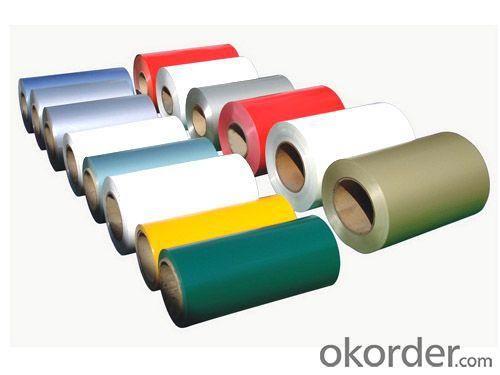
4.Pre-Painted Galvanized/Aluzinc Steel Coil Specification
Standard: AISI, ASTM, BS, DIN, GB, JIS
Grade: DX51D, DX52D
Thickness: 0.17-2.0mm
Brand Name: KMRLON
Model Number: coil
Type: Steel Coil
Technique: Cold Rolled
Surface Treatment: Coated
Application: Boiler Plate
Special Use: High-strength Steel Plate
Width: 20-1250mm
Length: customized
commoidty: pre-painted galvanized steel coil
Thickness: 0.13-4.0mm
width: 20-1250mm
zinc coating: 40-180g/m2
printing thickness: top side: 20+/-5 microns, back side: 5-7 microns
color: all RAL color
surface treatment: color coated
coil weight: 4-7 tons
coil ID: 508/610mm
packaging: standard seaworthy packing
5.FAQ of Pre-Painted Galvanized/Aluzinc Steel Coil
1. What’s the application of this product?
Roof, roof structure, surface sheet of balcony, frame of window, etc.
2. What’s the brand of the paint?
We use the best brand of all of the word—AKZO.
3. How about your company?
A world class manufacturer & supplier of castings forging in carbon steel and alloy steel,is one of the large-scale professional investment casting production bases in China,consisting of both casting foundry forging and machining factory. Annually more than 8000 tons Precision casting and forging parts are exported to markets in Europe,America and Japan. OEM casting and forging service available according to customer’s requirements.
4. How to guarantee the quality of the products?
We have established the international advanced quality management system,every link from raw material to final product we have strict quality test;We resolutely put an end to unqualified products flowing into the market. At the same time, we will provide necessary follow-up service assurance.
5. How long can we receive the product after purchase?
Usually within thirty working days after receiving buyer’s advance payment or LC. We will arrange the factory manufacturing as soon as possible. The cargo readiness usually takes 15-25 days, but the shipment will depend on the vessel situation.
- Q: I'm getting new strings on my dad's old acoustic guitar so I can learn how to play it and I'm wondering if I should get nylon or steel strings. Are there any major differences between the two aside from the nylon strings being easier on your fingers? Like do the Nylon strings sound different?
- If it's a classic guitar, then you should get nylon strings, because you can't use steel strings on a classic guitar, and you can't use nylon strings on an acoustic guitar , I would suggest that you buy a classic guitar, because it's really good for beginners.
- Q: How are steel coils used in the manufacturing of household appliances?
- Steel coils are used in the manufacturing of household appliances as they are shaped, cut, and formed into various parts such as panels, frames, and components. These coils provide strength, durability, and structural integrity to appliances like refrigerators, ovens, and washing machines, ensuring their stability and longevity.
- Q: What are the dimensions of steel coils used in automotive accessory manufacturing?
- The dimensions of steel coils used in automotive accessory manufacturing can vary depending on the specific application and requirements. However, typical dimensions for steel coils used in this industry range from 0.3 mm to 4.0 mm in thickness and from 600 mm to 2000 mm in width. The length of the coil can also vary, but it is commonly around 2000 meters.
- Q: Alright, First off i have an old plywood military box with galvanised steel corners, hinges etc (any part that must be strong) and its rusting! Some of the pieces have discoloration (like an oil stain on them) and other parts are full of this metallic dust. 1) Should i remove this box from my room?2) Is there any way or should i remove the powder on the part?3) Does this pose a serious health hazard?4) What are the oil stains?
- Wipe the powder of and the rest should be safe, unless you stub your toe on the rusty metal.
- Q: Can steel coils be used in the food processing industry?
- Indeed, the food processing industry can utilize steel coils. These coils frequently serve as the foundation for a diverse array of food processing equipment, including conveyor belts, food storage tanks, mixing tanks, and processing machinery. Steel, characterized by its durability and hygienic properties, possesses resistance against corrosion, rendering it appropriate for deployment in food processing environments. Furthermore, steel coils facilitate effortless cleaning and sanitization, guaranteeing the safety and cleanliness of the food processing equipment. In conclusion, owing to their robustness, longevity, and adherence to food safety regulations, steel coils enjoy widespread employment within the food processing industry.
- Q: What are the different types of steel coil surface finishes for aesthetics?
- For aesthetic purposes, steel coil surface finishes come in various types. These finishes are applied to the steel coil surface to improve its appearance and achieve the desired aesthetic appeal. Some popular steel coil surface finishes are: 1. Polished Finish: Achieved by using abrasive materials, this finish creates a smooth and reflective surface on the steel coil. Different levels of polishing can further enhance its high-gloss appearance. 2. Satin Finish: Also known as brushed finish, this type of surface finish involves using fine abrasives to achieve a soft and matte appearance on the steel coil. It provides a subtle sheen and a textured effect. 3. Etched Finish: This finish involves a chemical process to create patterns or designs on the steel coil surface. It is commonly used for architectural applications, as it allows for intricate and decorative designs. 4. Embossed Finish: By pressing or stamping a pattern onto the steel coil surface, this finish creates a raised design that adds texture and visual interest. 5. Powder Coated Finish: A dry powder is applied to the steel coil and then heated, resulting in a protective and decorative coating. Available in a wide range of colors, it provides a durable and vibrant finish. 6. Painted Finish: This finish involves applying a layer of paint to the steel coil surface. It allows for customization in terms of color and provides protection against corrosion and environmental factors. These examples highlight the different steel coil surface finishes available for aesthetic purposes. Each finish offers a unique appearance and can be selected based on personal preferences and project requirements.
- Q: Can steel coils be coated with tin?
- Yes, steel coils can be coated with tin through a process called tinplating. Tinplating provides corrosion resistance and enhances the appearance of the steel surface.
- Q: What are the different methods of surface cleaning for steel coils?
- Some of the different methods of surface cleaning for steel coils include mechanical cleaning, chemical cleaning, and high-pressure water cleaning. Mechanical cleaning involves using abrasive materials, such as brushes or sandpaper, to physically remove dirt, rust, or other contaminants from the surface of the steel coils. Chemical cleaning involves the use of specific cleaning agents or solvents to dissolve or loosen dirt and contaminants from the surface. High-pressure water cleaning utilizes a powerful jet of water to remove dirt and debris from the steel coils. These methods can be used individually or in combination depending on the specific cleaning requirements and condition of the steel coils.
- Q: How do steel coils contribute to energy savings in buildings?
- Steel coils contribute to energy savings in buildings through their use in HVAC systems. These coils are commonly used in air conditioning units and heat pumps, where they help transfer heat between the indoor and outdoor environments. By efficiently absorbing and dissipating heat, steel coils enable HVAC systems to regulate the temperature inside the building more effectively, reducing energy consumption and costs. Additionally, the durability and long lifespan of steel coils minimize the need for frequent replacements, further contributing to energy savings in the long term.
- Q: aLSO, DOES STEEL C45 REFER TO THE CARBON IN IT?ALSO, WHAT IS AIRCRAFT GRADE PLYWOOD AND WHERE DOES ONE GET IT
- chromium nickle steel aka stainless steel exact amount of chrome and nickle will determine type/grade numbers Check the google for steel type/grade Never head of aircraft grade, however,, there is marine grade - normally baltic birch with waterproof glue and no defects i.e. knots, etc. Very strong (also quite expensive) but worth it for the correct applications
Send your message to us
Pre-Painted Galvanized Steel Coil High Quality Green Color
- Loading Port:
- Shanghai
- Payment Terms:
- TT OR LC
- Min Order Qty:
- 100 m.t.
- Supply Capability:
- 20000 m.t./month
OKorder Service Pledge
OKorder Financial Service
Similar products
Hot products
Hot Searches
Related keywords
